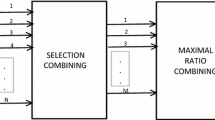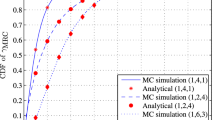Abstract
In this paper, we present an analytical framework to jointly investigate MRC diversity and multiuser scheduling under Rayleigh fading channels with the effect of combining errors under a low SNR regime. We derive spectrum efficiency expressions for multiuser scheduling systems with two different cases of multiuser scheduling, (1) Full feedback user scheduling (2) Limited feedback user scheduling with effects of combining errors. A signal to noise ratio (SNR) based user selection scheme is considered. For combining errors, correlation is defined as the magnitude of the complex cross-correlation between the transmission coefficients of the medium associated with pilot and message frequencies. We derive the probability density function and cumulative density function for the above cases. Adaptation policies like (1) Optimal power and rate adaptation policy (OPRA), (2) Optimal rate adaptation policy, (3) Channel inversion with fixed rate policy, (4) Truncated channel inversion with fixed rate policy are employed to improve system performance. It is observed that limited feedback user scheduling along with employment of adaptation policies yields better system performance compared to full feedback user scheduling. Further, OPRA policy yields maximum capacity among the four policies.







Similar content being viewed by others
References
Fochini, G. J. (1996). Layered space-time architecture for wireless communication in fading environment when using multi-element antennas. Bell Labs Technical Journal, 1(2), 41–59.
Tarokh, V., Jafarkhani, H., & Calderbank, A. R. (1999). Space-time block codes from orthogonal designs. IEEE Transactions on Information Theory, 45(5), 1456–1467.
Goldsmith, A. J., Jafar, S. A., Jindal, N., & Vishwanath, S. (2003). Capacity limits of MIMO channels. IEEE Journal on Selected Areas in Communications, 21(5), 684–702.
Telatar, E. (1999). Capacity of multi-antenna Gaussian channels. European Transactions on Telecommunications, 10(6), 585–596.
Torabi, M., Ajib, W., & Haccoun, D. (2008). Multiuser scheduling for MIMO-OFDM systems with continuous-rate adaptive modulation. In IEEE wireless communications and networking conference (WCNC 2008), New York (pp. 946–951).
Ajib, W., & Haccoun, D. (2005). An overview of scheduling algorithms in MIMO-based fourth-generation wireless systems. IEEE Transactions on Networks, 19(5), 43–48.
Gesbert, D. & Alouini, M. S. (2004) How much of feedback is multiuser diversity really worth? In IEEE International Conference on Communication, Paris, France (pp. 234–238).
Goldsmith, A. J., & Chua, S. G. (1997). Variable-rate variable-power MQAM for fading channels. IEEE Transactions on Communications, 45(10), 1218–1230.
Tarokh, V., Jaferkhani, H., & Calderbank, A. R. (1999). Space–time block codes from orthogonal designs. IEEE Transactions on Information Theory, 45(5), 1456–1467.
Holter, B., Alouini, M. S., Øien, G. E., & Yangz, H. C. (2004). Multiuser switched diversity transmission. In 60th IEEE Vehicular Technology Conference (VTC2004), Milan, Italy (pp. 2038–2043).
Stuber, G. L. (1996). Principles of mobile communications. Norwell, MA: Kluwer publishers.
Alouini, M. S., Simon, M. K., & Yang, H. C. (2004) Scan and wait combining (SWC): A switch and examine strategy with performance delay tradeoff. In Proceedings of IEEE first international symposium on control, communications, and signal processing (ISCCSP’04), Hammanet, Tunisia (pp. 153–157).
Zhang, Y., & Letaief, K. (2005). An efficient resource-allocation scheme for spatial multiuser access in MIMO-OFDM systems. IEEE Transactions on Communications, 53(1), 107–116.
Torabi, M., Aissa, S., & Soleymani, M. (2007). On the BER performance of space-frequency block coded OFDM Systems in fading MIMO Channels. IEEE Transactions on Wireless Communications, 6(4), 1366–1373.
Huang, J., Subramanian, V., Berry, R., & Agrawal, R. (2010). Scheduling and resource allocation in OFDMA wireless systems. Boca Raton: Auerbach.
Chan, P., & Cheng, R. (2007). Capacity maximization for zero-forcing MIMO-OFDMA downlink systems with multiuser diversity. IEEE Transactions on Wireless Communication., 6(5), 1880–1889.
Borst, S., & Whiting, P. (2001). The use of diversity antennas in high-speed wireless systems: Capacity gains, fairness issues, multiuser scheduling. Bell Laboratories Technical Memorandum.
Jiang, M., & Hanzo, L. (2007). Multiuser MIMO-OFDM for next-generation wireless systems. Proceedings of IEEE, 95(7), 1430–1469.
Rezki, Z., Haccoun, D., & Gagnon, F. (2008). Capacity of discrete-time non-coherent memory-less Rayleigh fading channels at low SNRs. In IEEE 19th international symposium on personal, indoor and mobile radio communications (PIMRC), Cannes, France (pp. 1–6).
Taylor, J. M., Hempel, M., Sharif, H., Ma, S., & Yang, Y. (2011). Impact of channel estimation errors on effectiveness of eigenvector-based jamming for physical layer security in wireless networks. In 16th IEEE international workshop on computer aided modeling and design of communication links and networks (CAMAD), Kyoto, Japan (pp. 122–126).
Andrews, A., & Khatibi, M. (2011). Performance of adaptive modulation with maximum ratio combining in different practical scenarios. International Journal of Advanced Science and Engineering Technology, 2(1), 81–86.
Yang, L., & Alouini, M. S. On the BER and capacity analysis of MIMO MRC systems with channel estimation error. In IEEE 7th international conference on wireless and mobile computing, networking and communications (WiMob), Shanghai, China (pp.193–198).
Jakes, W. (1994). Microwave Mobile Communications (2nd ed.). Piscataway, NJ: IEEE Press.
Subhashini, J., & Bhaskar, V. (2013). Capacity analysis of rayleigh fading channels in low SNR regime for maximal ratio combining diversity due to combining errors. IET Communications, 7(8), 745–754.
Papoulis, A. (1991). Probability Random Variables, and Stochastic Processes (3rd ed.). New York: McGraw-Hill.
Torabi, M., Ajib, W., & Haccoun, D. (2008) Discrete-rate adaptive multiuser scheduling for MIMO-OFDM systems. In 68th IEEE vehicular technology conference, (VTC 2008), Calgary, BC, Canada (pp. 1–5).
Alouini, M., & Goldsmith, A. (1999). Capacity of Rayleigh fading channels under different adaptative transmission and diversity combining techniques. IEEE Transactions on Vehicular Technology, 48(4), 1165–1181.
Gradshteyn, I., & Ryzhik, I. (1994). Table of integrals, series, and products (5th ed.). Sandiego, CA: Academic Press.
Bhaskar, V. (2007). Spectrum efficiency evaluation for MRC diversity schemes over generalized rician fading channels. International Journal of Wireless Information Networks, 14(3), 209–223.
Bhaskar, V., & Subhashini, J. (2014). Spectrum efficiency evaluation with diversity combining for fading and branch correlation impairments. Wireless Personal Communications, 79, 1089–1110. doi:10.1007/s11277-014-1919-4.
Bhaskar, V. (2007). Spectrum efficiency evaluation for MRC diversity schemes under different adaptation policies over generalized Rayleigh fading channels. International Journal of Wireless Information Networks, 14(3), 191–203.
Subhashini, J., & Bhaskar, V. (2012). Spectrum efficiency analysis of adaptive transmission with selection diversity in Rayleigh fading channels with branch correlation impairments. 2nd World Congress on Information and Communication Technologies, Trivandrum, India,. doi:10.1109/WICT.2012.6409101.
Subhashini, J., & Bhaskar, V. (2012). Capacity analysis of highly correlated Rayleigh fading channels for maximal ratio combining diversity. IEEE World Congress on Information and Communication Technologies, Trivandrum, India. 356–360. doi: 10.1109/WICT.2012.6409102.
Subhashini, J, & Bhaskar, V. (2012) Capacity analysis of correlated Rayleigh fading channels at low average signal to noise ratio for selection combining diversity. 2012 Annual IEEE India Conference on Innovations in Social and Humanitarian Engineering, Kochi, India, 293–298. doi: 10.1109/INDCON.2012.6420631.
Author information
Authors and Affiliations
Corresponding author
Rights and permissions
About this article
Cite this article
Subhashini, J., Bhaskar, V. Spectrum Efficiency Evaluation with Multiuser Scheduling and MRC Antenna Diversity with Effects of Combining Errors for Rayleigh Fading Channels with Feedback. Wireless Pers Commun 83, 791–810 (2015). https://doi.org/10.1007/s11277-015-2426-y
Published:
Issue Date:
DOI: https://doi.org/10.1007/s11277-015-2426-y




